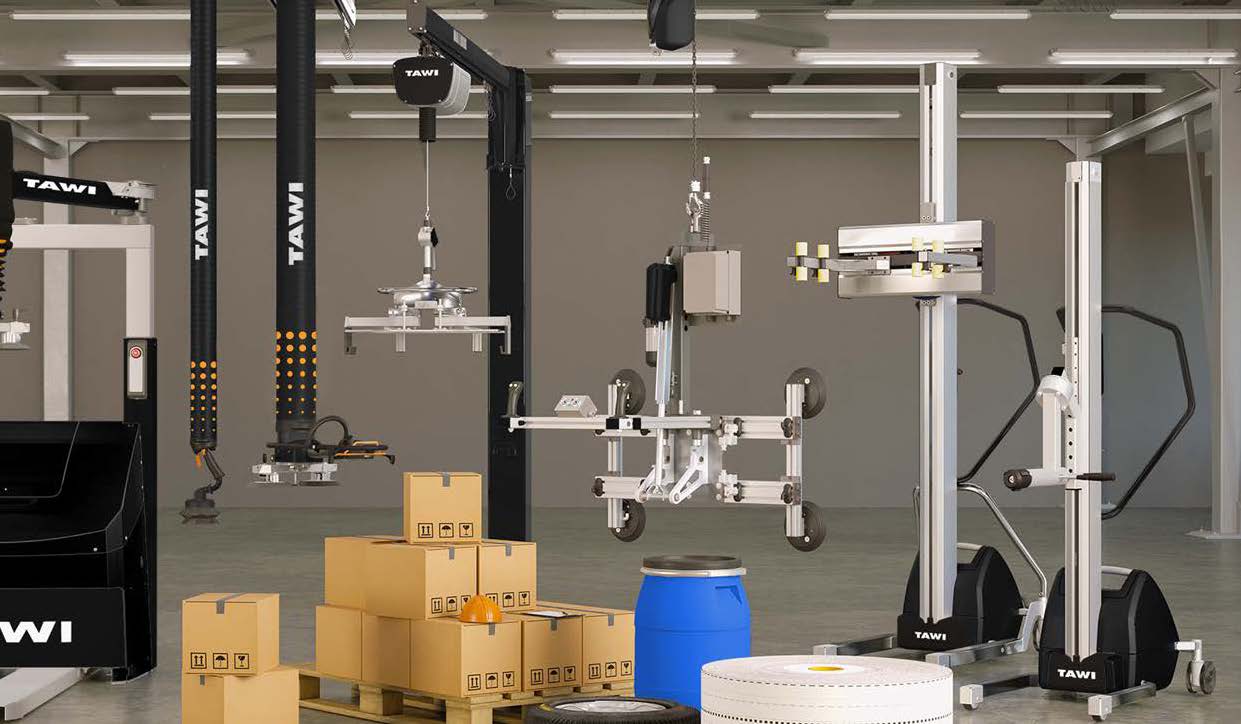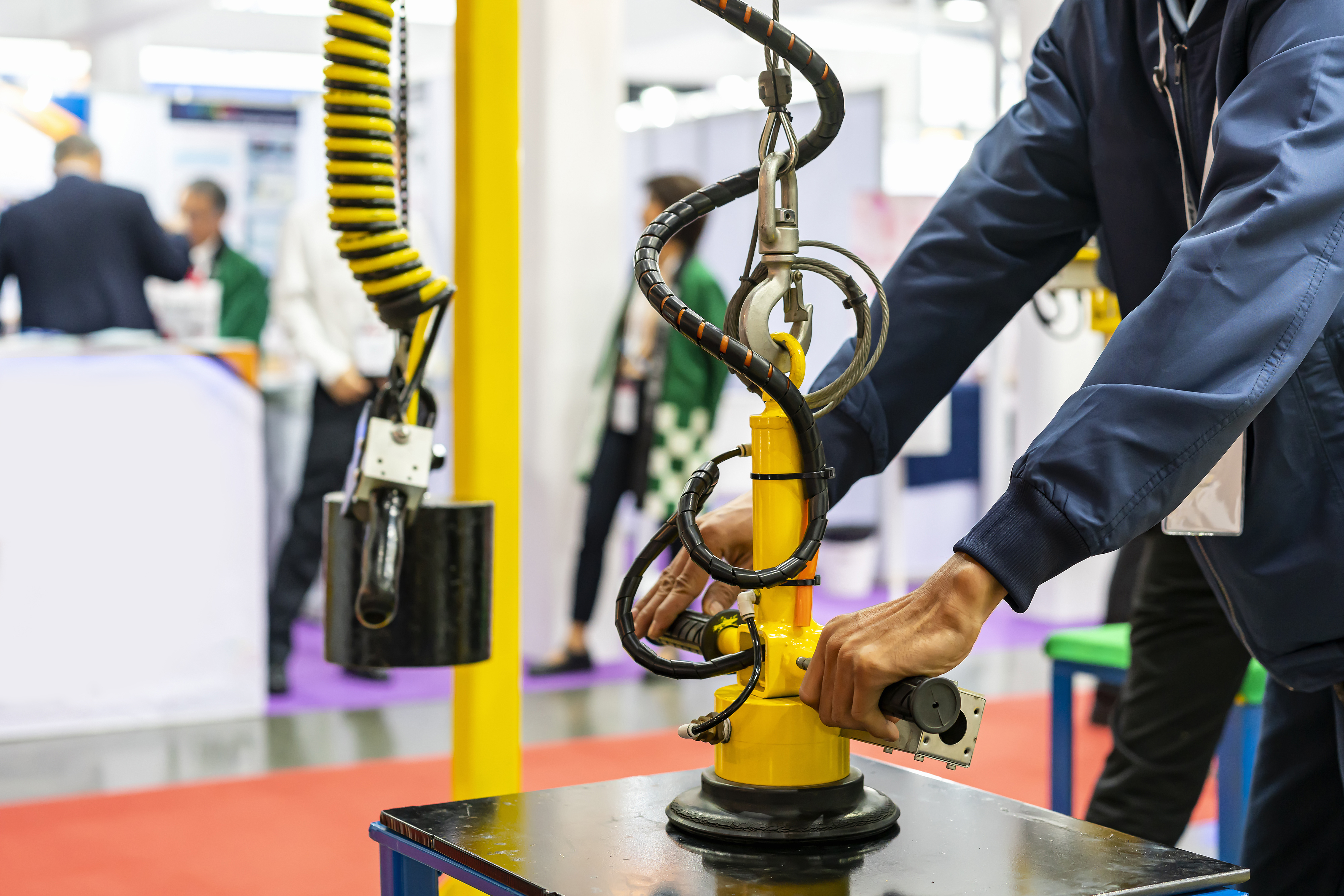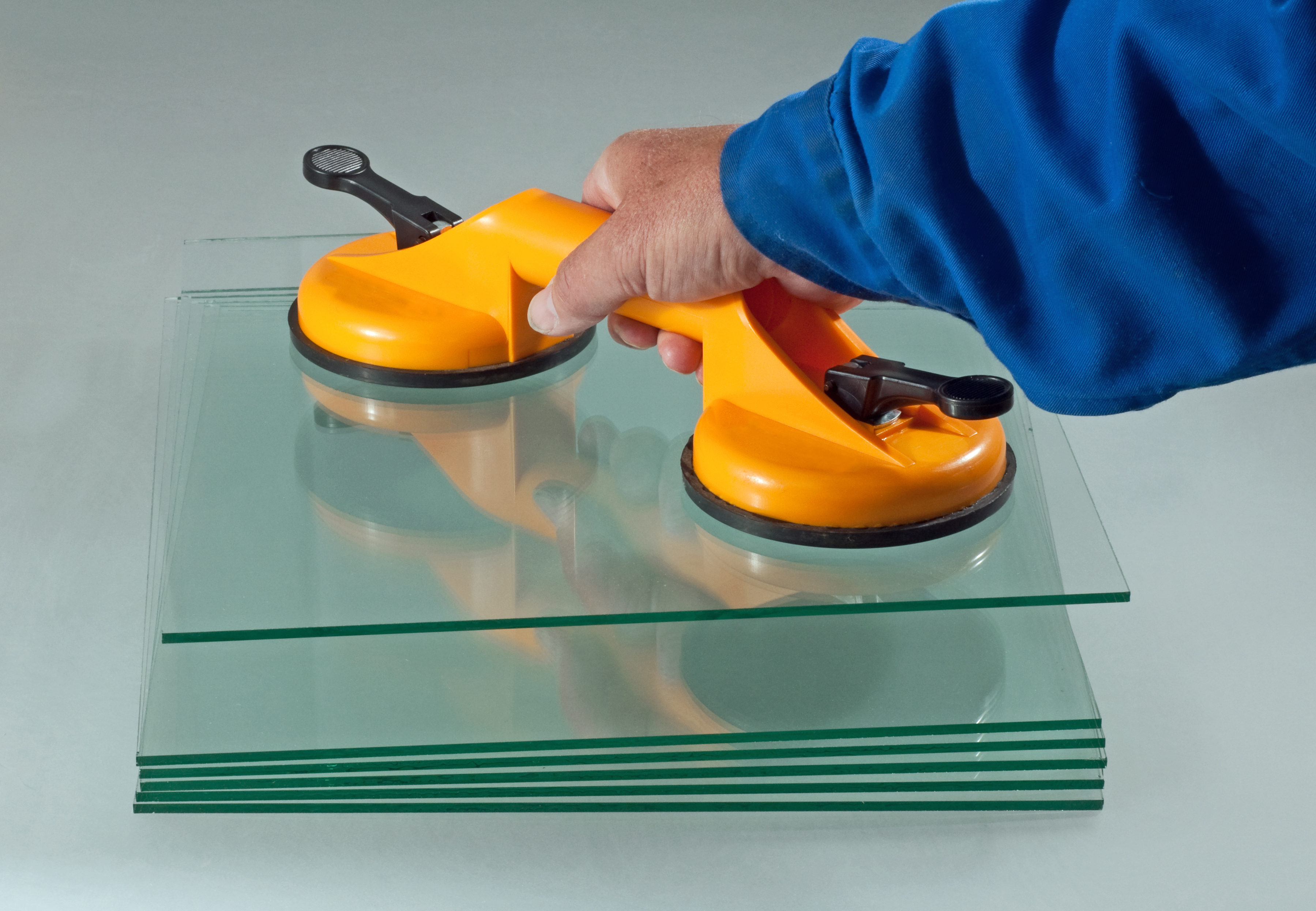Tuesday 1st August 2023

A vacuum lifter is an ergonomic lift assist for material handling that allows a single employee to lift materials up to 600 lbs. That means less team lifting, less chance for injury, and as a result, increased efficiency. It also eliminates the fatigue that an employee may experience throughout the day. This makes it so that the speed that they handle products is just as fast at the end of their shift as it is when they are fresh at the beginning.


Standard Parts in Vacuum Lifters:
- Vacuum Pump: The vacuum pump creates the necessary suction power by removing air from the lifter's vacuum chamber. It generates a vacuum force that enables the lifter to securely grip and lift objects.
- Vacuum Pad or Cup: This is the component that comes into direct contact with the object being lifted. The vacuum pad or cup is usually made of durable and flexible materials such as rubber or silicone. It forms an airtight seal with the object's surface, allowing the vacuum lifter to hold it firmly.
- Control Handle: The control handle serves as the interface between the operator and the vacuum lifter. It typically features ergonomic grips and buttons that enable the operator to control the lifter's functions, such as activating and releasing the vacuum suction.
- Frame or Mounting System: The frame or mounting system provides structural support to the vacuum lifter. It may consist of a rigid frame or a set of adjustable arms that allow the lifter to adapt to different object sizes and shapes.
- Vacuum Gauge: The vacuum gauge is a visual indicator that displays the level of vacuum pressure within the lifter's system. It helps the operator monitor the suction strength and ensure optimal lifting performance.
- Safety Features: Vacuum lifters often incorporate various safety features to protect both the operator and the lifted objects. These may include warning lights or alarms to indicate low vacuum levels, automatic release mechanisms in case of power failure, and overload protection to prevent excessive lifting.
- Power Source: Depending on the type of vacuum lifter, it may be powered by electricity, compressed air, or even battery power. The power source provides the energy needed to operate the vacuum pump and other electrical components
How do Vacuum lifters work or operate?
Vacuum lifters use vacuum technology to hold and lift various types of goods; everything from flour bags to stone slabs and glass panels. The vacuum lifting technique uses a vacuum pump, connected by an air hose to a lift tube. At the end of the lift tube is a suction head and a suction foot which will grip and hold the load. You will find that suction feet are available in various shapes and sizes, designed for the type of goods you need to lift. The suction foot or suction cups create an air-tight seal between the load and the lifter to guarantee a safe hold of the load during the lifting activity. A vacuum pump (or ejector pump) creates vacuum between the suction cups and the load. By adjusting the vacuum level through a control handle, the operator can easily alter the lifting height. This type of suction lifting is safe and gentle for both operator and goods. The suction cups hold the load securely without damaging it, and the operator can safely lift heavy goods with no physical strain.
Let's delve further into the working mechanism of vacuum lifter according to the different parts and components:
1.Vacuum Generation:
- Vacuum Pump: Vacuum lifters are equipped with a vacuum pump, which creates a low-pressure environment by removing air molecules from a sealed chamber.
- Power Source: The vacuum pump is typically powered by an electric motor or a pneumatic system, depending on the design of the lifter.
2.Suction Cup Assembly:
- Suction Cups: The lifter contains one or more suction cups made of a flexible, airtight material such as rubber or silicone. These cups come in various shapes and sizes to accommodate different types and sizes of objects.
- Vacuum Channels: Within the suction cups, there are channels or grooves that allow the vacuum to reach the surface of the object being lifted.
- Sealing Gaskets: The suction cups are fitted with sealing gaskets that ensure an airtight seal when pressed against the object's surface.
3.Control System:
- Vacuum Control Valve: The control system includes a vacuum control valve that regulates the flow of air into the suction cups. This valve can be manually operated or controlled electronically.
- Pressure Sensors: Pressure sensors are often incorporated into the lifter to monitor and maintain the desired vacuum level. They provide feedback to the control system, enabling adjustments to the suction force as needed.
4. Operation:
- Attachment: To lift an object, the suction cups are positioned on its surface. The lifter's control system activates the vacuum pump, creating a low-pressure environment within the suction cups.
- Vacuum Creation: As the pump removes air from the cups, the atmospheric pressure outside forces the cups onto the object, creating a vacuum seal. The suction cups conform to the object's contours, maximizing contact and grip.
- Load Handling: With the vacuum seal established, the lifter can safely raise and transport the object. The suction cups maintain their grip by continuously maintaining the vacuum pressure, ensuring secure handling.
- Release: When the object needs to be released, the vacuum control valve is opened, allowing air to enter the suction cups. This breaks the vacuum seal, detaching the object from the lifter.
5. Safety:
- Vacuum Monitoring: Some vacuum lifters have sensors that continuously monitor the vacuum level. If the vacuum drops below a certain threshold, an alarm may be triggered to alert the operator of a potential failure.
- Backup Systems: To prevent accidents due to power failure or other issues, vacuum lifters may incorporate backup systems such as mechanical clamps or additional safety latches to provide redundant securing mechanisms.
Different Components in our Vacuum Lifters from Tawi
Most of what you see in the video abovve is what we call the lift tube assembly. We have our Suction feet which are what come in contact with the product – these are completely configurable and easily interchanged for different applications. Next we have the suction head, which is what the operator uses to control the lift.
Our Vacuum Lifters from Tawi have two standard types of suction heads – The the high-frequency model is designed for rapid, single hand operation, and The multi-functional lifter which can be operated with two hands, and allows for more customizations and greater lifting capacities when compared to our high-frequency lifter.
The suction head and suction foot are connected to the lift tube. This is the item that facilitates the vertical movement of material and carries the load of the lift. There are no wires or cables in here – it’s all vacuum pressure doing the work, paired with several air valves. The lift tube expands and contracts based on the level of vacuum the operator desires. Higher vacuum pressure raises the material. Lower pressure lowers the material. The lift tube also has a top swivel, which allows the lift to spin freely without any need to uncoil the hosing.
Structural Support System
All vacuum lifters have some sort of structural support system. In many cases this is a jib or bridge crane, but can also be a portable jib crane that can be moved throughout a facility via fork lift or we even offer our mobile order picker which is a completely mobile solution that can integrate with a fork lift or pallet jack for fast pace picking and moving. Lastly, what generates the vacuum force of the machine is the vacuum pump. Each lifter is powered by a pump and is available with a sound enclosure to reduce ambient noise levels in your facility.
The vacuum pump can be placed on the floor near the lifter or can be elevated so it is out of the way, saving floorspace and reducing the possibility of it getting in the way during cleaning or washdown processes.
Vacuum Lifter Applications:
Warehouses: Vacuum lifters can offer invaluable benefits in various warehouse environments, significantly optimising material handling processes. In e-commerce fulfillment centers, vacuum lifters can enhance efficiency by effortlessly lifting and placing items of various shapes and sizes, reducing strain on workers and increasing order processing speed.
In a pharmaceutical warehouses, where delicate and precise handling is crucial, vacuum lifters can ensure safe transportation of sensitive medical equipment and supplies, minimising the risk of damage and contamination.
Manufacturing: Vacuum lifters play a crucial role in streamlining material handling processes, increasing efficiency, and improving workplace safety in manufacturing industry by helping to load and unload materials onto machinery like CNC machines, cutting tables, or assembly lines. This ensures a smooth workflow and faster production cycles.
Some other examples of use of Vacuum lifters in Manufacturing:
- Lifting Glass panels/Metal sheets: Can easily lift materials, such as metal sheets, glass panels, or large components used in manufacturing which eliminate the need for manual lifting, reducing the risk of worker injuries and fatigue.
- Production Lines: Vacuum lifters can be integrated into automated production lines, contributing to a seamless and efficient manufacturing process. They can pick and place items swiftly, ensuring consistent output and reducing downtime.
Packaging Industry:
Our lifters can enable quick and seamless handling of packaged goods, enhancing the speed and efficiency of the packaging process. They can swiftly lift and place boxes, cartons, and other packaging materials onto conveyors or pallets.
Tiles Industry:
They are highly beneficial for handling tiles in various industries, including construction, manufacturing, and distribution. Workers can lift and move tiles without putting undue strain on their backs or risking injuries associated with manual handling. Our Vacuum lifters are also adaptable to handle different types of tiles, including ceramic, porcelain, marble, and glass, making them suitable for various applications.
Vacuum Lifter Maintenance
In terms of maintenance, the system requires simple filter and gasket replacements based on the level of use. Our Supplier TAWI offers a preventative maintenance program and we have our customer service team that can assist with any troubleshooting or part replacements. This makes it easier to help maintain and use our vacuum lifters. If the system loses power, it won’t drop the product, instead it will slowly lower to the ground. Our Supplier Tawi manufactures the majority of the components in the system. That means we have a unique ability to manufacture everything to your specifications all the way down to materials.
For example, if you have a unique application or if you are in a sanitary or washdown situation, we can customize our product and everything can be built in stainless steel or FDA compliant materials to meet your needs.
Our Vacuum Lifting Devices From Tawi
Our extensive range of vacuum lifting tools from Tawi are designed to cater to all your lifting needs with unmatched precision and efficiency. Whether you're working in the construction industry, manufacturing sector, or any other field that requires heavy lifting, our vacuum lifting tools are the perfect solution. Engineered with cutting-edge technology, our vacuum lifters provide a secure and reliable grip on a wide range of materials, from glass and metal to wood and concrete. With their ergonomic design and user-friendly controls, our vacuum lifting tools ensure maximum operator comfort and safety. .
At Prolift handling, we take pride in being a leading provider of vacuum lifters in Ireland. With offices conveniently located in both Cork and Dublin, we are well-equipped to serve customers throughout the country.
With combined experience of more 200 years in the material handling industry, our team is committed to delivering top-quality products that meet the highest standards of performance, reliability, and safety. We understand the importance of streamlining material handling processes and improving workplace efficiency, which is why our vacuum lifters from Tawi are designed to optimize productivity while ensuring the well-being of your employees.
Whether you're based in Dublin, Cork, or anywhere else in the country, we have you covered! we understand the value of personalised service and face-to-face interactions when it comes to choosing the right vacuum lifter for your needs. That's why our dedicated team of multiple on-road sales representatives is just a stone's throw away from your location, ready to provide you with expert advice and assistance.


